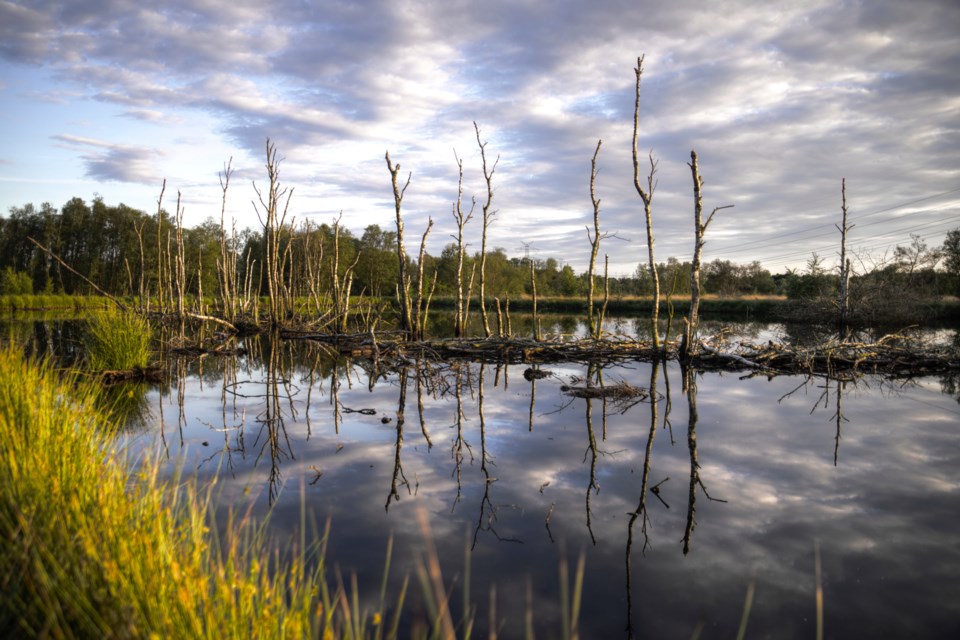Wetlands are odd places. Most people associate them with biting insects, which ensure they keep visits to wetland brief. That’s a pity because wetlands harbour an impressive variety of plant life. Many animal species make wetlands their homes for at least part of the year.
In medieval times wetlands were felt to be a source of disease. Malaria was so named because of the miasma (bad air = ‘mala aria’) associated with wetlands. One thousand workers died during construction of the Rideau Canal (Ottawa to Kingston). Astonishingly, half were malaria victims — malaria is not just a tropical disease.
Malaria was eradicated from Europe and North America, largely by draining mosquito-infested wetlands. The State of New Jersey is styled the “Garden State,” but in 1901, it was unofficially the “Mosquito State.”
In 1912, after a decade of intense lobbying by the state entomologist, a bill mandating mosquito control was signed into law. New Jersey’s marshes were drained, mosquito numbers plummeted, and malaria was almost eradicated by 1934.
For the most part, marshes were drained for agriculture. The soil in former wetlands is rich and may be tens of metres thick. England’s fenland, a lowland arc around The Wash, was drained between 1630 and 1650 by Dutch engineers.
As the waterlogged peat dried, it shrank, dropping its surface below that of nearby rivers. Dikes were built (100 km of sea defences, 160 km of river embankments) and pumps installed, powered by Dutch-style windmills. Wind power gave way to steam, and then diesel and, finally, electricity.
Florida’s Everglades, and Louisiana’s bayous, are well known. Both suffered severe degradation due to ill-advised engineering works. These have been partly reversed to correct the damage. Closer to home, the Holland Marsh was drained to create some of Ontario’s most productive farmland. That, too, caused problems, partly by doubling Lake Simcoe’s phosphorus inputs, which promoted weed growth and algal blooms.
Other wetlands were drained for suburban housing. As extreme weather has become normal, some of these areas are now flooding; building permits should never have been granted.
Barrie has a small wetland (Bear Creek Eco Park), the eastern edge of which is crossed by Ferndale Drive, south of Tiffin Street. Just three to four kilometres west of Barrie’s western edge lies the Minesing Swamp. This “wetland of international significance” extends over 6,000 hectares.
There are many types of wetland. Some are tropical, others arctic. Some cling to hillsides. Some are grassy or harbour shrubby vegetation; others are forested. Some — improbably — are even found in deserts. At their base, one generally finds peat — slowly decomposing vegetation.
Humans have used peat for thousands of years. Dried peat was a heating or cooking fuel where firewood was scarce. Peat was pounded into gaps in house walls for draft-proofing. Today, we mine peat for gardening. Garden centre plants are potted into peat. Surprisingly, this is a huge market and, with machinery mining the peat, the potential for environmental damage is great.
The question we should consider is, what services do wetlands provide?
Wetlands harbour a great diversity of plant and animal life. For many people, this is intangible and hard to value in dollar terms. This is a pity, but consider two readily measured services.
During dry spells, wetlands gradually release water, helping maintain river flows. When rain does fall, wetlands absorb the water like a moist sponge. In doing so, they slow runoff, spreading it over a longer period, often preventing flooding. Even when flooding does occur, its peak height is reduced.
When wetlands are drained for agriculture or settlement, embankments must be erected to keep streams from overflowing the repurposed land. Long stretches of the Mississippi are contained by levees; heavy rainfall cannot be absorbed by land full of impermeable surfaces like roads, parking areas and rooftops.
Another underappreciated service provided by wetlands is carbon sequestration. Worldwide, peatlands are thought to store more carbon than all other types of vegetation combined, despite representing just three to four per cent of Earth’s surface.
The Congo just auctioned five per cent of its wetland, the world’s fourth-largest, for petroleum exploration. Exploration and exploitation will require draining an area of peat containing about three years’ worth of the world’s fossil-fuel-derived carbon emissions. But, what right do we have to ask one of the world’s poorest countries not to exploit its resources?
In our Far North, as climate change melts Canadian permafrost, our once-frozen wetlands begin to emit methane, a greenhouse gas 20 to 25 times more potent than carbon dioxide.
Canadians must stop pretending we contribute little to the world’s carbon emissions. Our greenhouse gas emissions are substantial and we need to pull our weight in the battle to control climate change.
Peter Bursztyn is a self-proclaimed “recovering scientist” who has a passion for all things based in science and the environment. The now-retired former university academic has taught and carried out research at universities in Africa, Britain and Canada. As a member of BarrieToday's community advisory board, he also writes a semi-regular column. If you have a question Peter might be able to answer or something you're curious about, email us at [email protected].



